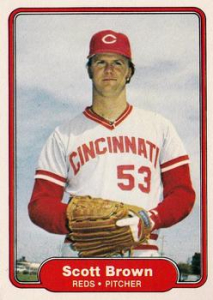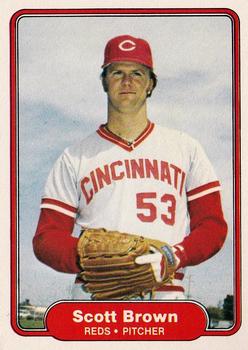August 11, 1981: Reds’ Scott Brown records his only major-league win as Fernando Valenzuela’s struggles continue
 Despite widespread fan anger over the just-ended strike, almost 46,000 people showed up to watch the National League West’s two top teams, the Dodgers and Reds, reboot their rivalry for the division title. Rookie sensation Fernando Valenzuela was on the mound for Los Angeles. But it was a rookie in the Reds’ bullpen who emerged with the win—even though Cincy scored the deciding run before he ever threw a pitch.
Despite widespread fan anger over the just-ended strike, almost 46,000 people showed up to watch the National League West’s two top teams, the Dodgers and Reds, reboot their rivalry for the division title. Rookie sensation Fernando Valenzuela was on the mound for Los Angeles. But it was a rookie in the Reds’ bullpen who emerged with the win—even though Cincy scored the deciding run before he ever threw a pitch.
Because of Valenzuela, the crowd on the 11th was almost 11,000 larger than the prior evening. Even so, it was subpar by LA standards—10,000 less than Dodger Stadium’s capacity and well under the 51,092 the Dodgers averaged in Valenzuela’s five pre-strike home starts. Opening Day in April had drawn 50,511, “Re-Opening Day” on Monday the 10th just a paltry 35,120. That was 11,000 below the Dodgers’ pre-strike regular-season average.
Why was attendance down? Fans were angry—at both the players and the owners—over the first midseason strike in big-league history. Some 713 games were canceled between June and August. Not just in LA, but across the major leagues, average attendance had been up more than 6 percent before the strike. Afterward, it tumbled 13 percent. Fans were voting with their feet.
Anticipating backlash, the owners adopted a split-season playoff format, hoping to lure fans back by creating new pennant races and more playoff games. The standings were reset. Everyone got a fresh shot at the postseason. Teams in first place when the strike started were declared “first-half” winners and awarded playoff berths. Their opponents would be the “second-half” winners.1
That change made the three-game Re-Opening series—and especially the contest on the 11th—crucial for Cincinnati. The Reds had lost the “first half” to the Dodgers by just a half-game. So LA already had a playoff berth. If Cincy wanted in, winning head-to-head games with Los Angeles would be key. But LA won Monday’s series opener, and now, the Reds faced Fernando.
Valenzuela, however, had begun to appear human. After winning his first eight starts, five of them shutouts, he lost four of the next six and failed to get past the fourth inning in two of those games. Still, he was 9-4 with a 2.45 ERA, and on his way to winning Rookie of the Year and the Cy Young Award.
Cincy had roughed Valenzuela up in their first meeting, in late May, and on this night, he again struggled.2 He loaded the bases and gave up a two-run single to Ray Knight in the first inning. In the third, he yielded a solo home run to Dave Concepción. After a one-two-three fourth inning, he walked Concepción and George Foster with one out and the score tied, 3-3, in the fifth, and that was the end of Valenzuela’s night. Terry Forster came in and ended the threat.
In the bottom of the fifth, Dusty Baker walked with one out, Steve Garvey singled Baker to third and Ron Cey doubled him home, breaking the tie. That was it for Reds starter Mario Soto. Doug Bair came in to face Pedro Guerrero and unleashed a wild pitch that enabled Garvey to score from third. Guerrero teed off for a double to right-center, and Los Angeles pulled ahead, 6-3.
Both teams went quietly in the sixth. Bair was due to be Cincinnati’s leadoff hitter in the seventh, but instead manager John McNamara had Rafael Landestoy pinch-hit and told the bullpen to get Scott Brown get ready. Brown, a big right-hander from tiny DeQuincy, Louisiana, had pitched well at Indianapolis in 1980 and would have been on the big-league roster coming out of 1981 spring training. But baseball’s labor unrest had reared its ugly head and McNamara gave Brown a difficult choice. “He said, ‘It looks like there’s going to be a strike,’” Brown recalled. “‘There’s nothing we can do about that. What would you rather do? Draw a paycheck or go on strike?’ I was married and had a family to feed, so I said, ‘Well, sir, I need to draw a paycheck.’”3 Brown went back to Indianapolis and had the best minor-league season of his career, then rejoined the Reds after the strike.
While Brown was warming up for his major-league debut, Landestoy grounded out to second and Dave Collins struck out. Ken Griffey singled to right and Concepción pushed him to second with a single to center. George Foster drove in Griffey and moved Concepción to third with a single to right-center. Dan Driessen hit a shot into the right-field pavilion, and so, by the time Brown took the mound for the first time—in front of a crowd 15 times the population of DeQuincy—Cincy had come from behind to lead, 7-6.
“You know what?” said Brown, “Remember when they used to have you come in from the bullpen on that little cart? Well, I ran. And when I got to the mound, my knees were like rubber. I was terrified. All I remember is McNamara saying, ‘Just rear back and chunk it.’ That was it. Once I threw the first pitch, they [the fans] wasn’t there no more. Once I started throwin’, they were gone. All I saw was my catcher [Joe Nolan].”4
Brown got both Baker, the first batter he faced, and Garvey, to ground out. Cey poked a single to left, but Brown got Guerrero out on a routine fly to right. Bobby Castillo replaced Forster for LA in the eighth and retired Ron Oester and Joe Nolan on infield grounders. Brown was due up next, and McNamara surprised him. “I was sitting there, and I figured I’m out,” said Brown. “He looked over at me and said, ‘You going to get on deck or what? So, I went out there and found a bat. I have no idea whose it was.” It didn’t matter. Castillo struck him out. “I never saw the ball,” admitted Brown.5 It was his only major-league at-bat.
Asked about it later, McNamara told reporters, “He was outstanding. We only wanted one inning out of him, but he was so sharp, we stayed with him. The Dodgers aren’t the easiest lineup to face in your major league debut.”6
Brown set down the Dodgers in order in the eighth. Mike Scioscia, Bill Russell, and pinch-hitting Rick Monday were all retired on infield grounders. Brown went back out for the ninth, the Reds still up by one, and got Davey Lopes to fly out to center. But Landreaux singled and, with the hot-hitting Dusty Baker up next, McNamara brought in Reds closer Tom Hume, ending Brown’s debut. Baker flied out to center and Garvey struck out as Hume registered his sixth save.
After the game, Brown learned he had been awarded the win, even though Bair was still the pitcher of record when Cincinnati scored the winning run. Official scorers can award a win to someone other than the pitcher of record if they think a subsequent relief pitcher had a more significant impact on the game’s outcome. Bair had allowed a run to score on a wild pitch and given up a run-scoring double in 1⅔ innings. Brown gave up just two harmless singles and no runs in 2⅓ innings.7 “I had no idea they were going to give me the win,” said Brown. “Bair wasn’t real happy about that! But hell, I had no clue that could happen.”8 It could, and Brown was 1-0 in the big leagues. He made nine more appearances that season, but got no more wins. He was traded to Kansas City for Clint Hurdle the following December, but missed the 1982 season with a torn medial collateral ligament and had Tommy John surgery. After arduous rehab, he returned for 1983 spring training with the Royals, only to have the ulnar nerve in his pitching arm snap. His playing career ended.9
LA finished fourth in the second half, six games behind Houston—but still made the playoffs because of its “first-half” title. The Reds? They again finished second in the NL West, this time 1½ games behind Houston, and failed to make the playoffs. Ironically, if the owners had not adopted the split-season format at the urging of Reds executive Bob Howsam,10 Cincinnati would have had the best record in baseball and would have won the NL West by five games over Los Angeles and six over Houston. LA proceeded to beat the Astros, Expos, and ultimately, the Yankees for the World Series title.
Acknowledgments
This article was fact-checked by Bruce Slutsky and copy-edited by Len Levin.
Sources
In addition to the sources cited in the Notes, the author accessed BaseballAlmanac.com, BaseballReference.com, and Retrosheet.org.
https://www.baseball-reference.com/boxes/LAN/LAN198108110.shtml
https://www.retrosheet.org/boxesetc/1981/B08100LAN1981.htm
Notes
1 Bowie Kuhn, Hardball: The Education of a Baseball Commissioner (New York: Times Books, 1987), 360.
2 “Fernandomania Isn’t Same; Neither Is He as Reds Win,” Los Angeles Times, August 12, 1981: D1.
3 Author interviews with Scott Brown on November 22 and November 29, 1981.
4 Brown interviews; “Reds Rookie Wins Despite ‘Pure Terror,’” Columbus (Ohio) Dispatch, August 12, 1981: D1.
5 Brown interviews.
6 “Reds Rookie Wins Despite ‘Pure Terror.’”
7 Official Baseball Rules, 9.17(c)
8 Brown interviews.
9 Brown interviews.
10 Kuhn, 356.
Additional Stats
Cincinnati Reds 7
Los Angeles Dodgers 6
Dodger Stadium
Los Angeles, CA
Box Score + PBP:
Corrections? Additions?
If you can help us improve this game story, contact us.


